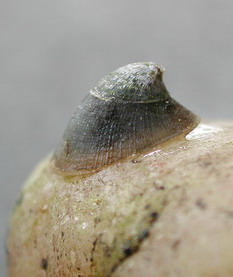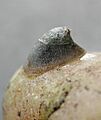Ancylus fluviatilis facts for kids
Quick facts for kids Ancylus fluviatilis |
|
|---|---|
 |
|
| Conservation status | |
| Scientific classification |
The river limpet (Ancylus fluviatilis) is a very small, freshwater snail. It's a type of limpet, which means it has a shell shaped like a cone. This tiny creature is an aquatic mollusk that breathes air, even though it lives underwater! It belongs to a group of snails called Planorbidae, which includes the ram's horn snails.
Contents
About the River Limpet
What Does It Look Like?
The river limpet has a shell that is usually about 5 to 8 millimeters long. That's less than half an inch! Its shell looks like a small cone, and the tip of the cone points backward. If you look at the shell from above, the tip seems blunt, but from the side, it looks more pointed.
The shell is thin and you can almost see through it. It has fine lines and a net-like pattern on its surface. The color can be light yellowish, reddish-brown, or a dull pale brown. The limpet itself is grey with small black dots near its head. Its shell covers almost its entire body. It has two triangular tentacles with eyes at their base, helping it to see its surroundings.
Where Do River Limpets Live?
River limpets are found across many parts of Europe, especially in the north, west, and central areas. You can find them in countries like Great Britain, Ireland, Germany, France, and the Netherlands. They are also found in parts of North Africa, such as Morocco and Tunisia, and even in some highlands of Ethiopia. They have also been seen in parts of the Middle East, like Saudi Arabia and Yemen, and in the Caucasus region.
However, you won't find them in the far north of Norway, southern Sweden, or Finland. In some warmer areas, like the Mediterranean, there are similar types of limpets that might be different species, but scientists are still studying them.
What Kind of Home Do They Like?
River limpets love to live in water that is rich in oxygen and flows quickly. This means you'll often find them in rivers, streams, and even in springs where water bubbles up from the ground. They don't like water that freezes in winter.
They need a hard surface to live on, like rocks, with just the right amount of algae growing on them. Algae is their main food source. This is why they are common in rivers and streams in Central Europe. In North America and Western Europe, they can also be found in lakes.
Unlike some other freshwater snails, river limpets can live in water that is a bit acidic. If the water level drops and they are exposed, some river limpets, especially those from southern Europe, can create a protective layer under their shell to survive. Those in Central Europe might just stick very tightly to a stone surface to get through dry periods.
Images for kids




